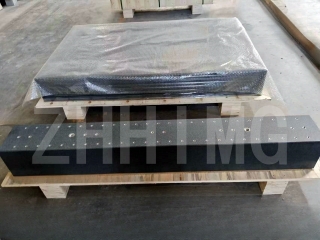Granite is an incredibly durable and stable material that has been used in a variety of industries for centuries. One of its most impressive applications is in optical systems, particularly those used in semiconductor equipment. In this article, we will explore how granite is used in the creation of these devices and the benefits it provides.
The semiconductor industry is responsible for producing the electronic components that are used in computers, smartphones, and a plethora of other devices. The manufacturing process involved in creating these components is incredibly precise, requiring machinery that is capable of handling tolerances at the nanometer level. To achieve this level of precision, semiconductor equipment manufacturers turn to granite as their material of choice.
Granite is a naturally occurring rock that is quarried from the earth and then cut into slabs and blocks. These slabs are then machined to precise tolerances using advanced CNC machinery. The result is a material that is incredibly stable and able to withstand the stresses and forces necessary for creating semiconductor components.
One of the primary applications of granite in semiconductor equipment is in the creation of wafer chucks. Wafer chucks are used to hold silicon wafers during the fabrication process, ensuring that they remain flat and stable during the various steps involved in creating electronic components. Granite is an ideal material for wafer chucks because of its high stiffness, low thermal expansion coefficient, and excellent thermal conductivity. These properties ensure that wafer chucks made from granite provide a stable and consistent platform for the manufacturing of semiconductor devices.
In addition to wafer chucks, granite is also used in other areas of semiconductor equipment. For example, granite is often used as a base material for other components, such as scientific instruments and metrology tools. These components require a stable base to ensure accurate measurements and readings. Granite provides the necessary stability and durability to ensure that these instruments function as intended.
Another benefit of using granite in semiconductor equipment is its ability to dampen vibrations. Vibrations can have a significant impact on the precision required for manufacturing semiconductor devices. Granite's high specific gravity and stiffness allow it to dampen vibrations, ensuring that the equipment remains stable during operation.
In conclusion, granite is an essential material in the semiconductor industry, particularly in the manufacturing of equipment used to create electronic components. Its unique properties, including high stiffness, low thermal expansion coefficient, and excellent thermal conductivity, make it an ideal choice for wafer chucks and other components. Its ability to dampen vibrations is also a critical factor in ensuring the precision and accuracy required in semiconductor equipment. With its durability and stability, granite is the material of choice for semiconductor equipment manufacturers, and it will undoubtedly continue to play an essential role in this industry for years to come.
Post time: Mar-19-2024

